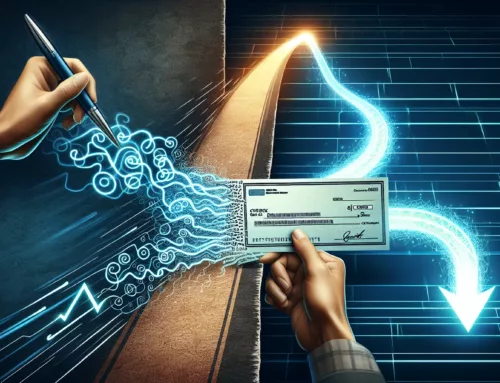BLOGS
Deciphering ACH vs EFT: Choosing the Right Money Transfer for You

When transferring money, understanding the differences between ACH and EFT is crucial for making the right choice. ACH, or Automated Clearing House, offers a network for direct deposits and payments mainly within the US, while EFT, or Electronic Funds Transfer, is a broader category encompassing various electronic payment methods, including ACH. This article will delve into what each system entails, their pros and cons, and how to determine which is best for your financial transactions.
Key Takeaways
- ACH (Automated Clearing House) is a type of EFT (Electronic Funds Transfer) that operates within the US for direct deposits and payments, characterized by batch processing, cost-effectiveness, and faster processing than paper checks.
- EFT encompasses a variety of electronic payment methods, including ACH, wire transfers, e-checks, and credit card payments, and facilitates both domestic and international transactions, breaking the constraints of national borders.
- Security in electronic transfers is paramount, with ACH renowned for stringent security measures and EFT requiring diligent protection practices. While ACH benefits from federal regulation and NACHA oversight, all forms of EFT depend on strong security protocols to safeguard financial transactions.
Understanding the Basics: ACH and EFT Defined

In the financial world, it is important to comprehend terms like ACH and EFT to effectively navigate the digital payment landscape. At its core, ACH, or Automated Clearing House, is a specific type of electronic funds transfer used primarily for direct deposits and payments within the United States. Picture it as a massive, highly efficient automated clearing house network that connects banks and credit unions, allowing them to:
- Send and receive funds with ease
- Process direct deposits
- Facilitate bill payments
- Handle business-to-business transactions
On the broader spectrum, EFT encompasses a wide array of electronic payment methods, including but not limited to ACH transfers. This includes everything from wire transfers to online payment services, making EFT the umbrella under which ACH cozily resides.
The Essence of ACH Payments
The ACH network is like the unsung hero of electronic payments, working tirelessly behind the scenes to ensure your money transfers happen smoothly and securely. Governed by Nacha, the organization that regulates ACH payments, this network facilitates two main types of transactions: ACH Credit and ACH Debit.
With ACH Credit, you can push funds into an account – think direct deposits like payrolls and social security benefits. ACH Debit, on the other hand, pulls funds from an account, making it perfect for automating those monthly bill payments. Not only are ACH payments cost-effective, especially for recurring transactions, but they also boast faster processing times compared to the snail-paced paper checks.
It’s important to remember that ACH payments operate exclusively within the US and its territories, under the vigilant security of Nacha. The sheer volume of ACH transactions in 2021, a whopping 29.1 billion, speaks volumes about the network’s integral role in our financial system.
Electronic Funds Transfer (EFT) Explained
EFT is the grand tapestry of electronic payment methods, weaving together various strands from:
- ACH
- wire transfers
- e-checks
- credit card payments
- e-wallets
It represents the digital movement of money between accounts, cutting out the need for bank employees to manually handle the transactions. EFTs cover a broad spectrum of payment methods.
While ACH is an internal network for the US, EFT breaks borders, facilitating international money transfers and wire transfers, which are particularly useful for moving large sums across the globe. Whether it’s for e-commerce purchases or sending money to a friend abroad, EFTs are the go-to for electronic bank transfers and payments in today’s interconnected world.
Unraveling the Differences: ACH vs EFT

Choosing between ACH and EFT is akin to weighing the pros and cons of a dependable hatchback versus a flashy sports car – each gets you where you need to go, but the journey varies. ACH payments are processed in batches, which means they’re not immediate. This batch processing generally makes ACH transactions slower than some other EFT methods, such as wire transfers, which can often transfer funds in real-time. However, ACH has a trump card up its sleeve: cost. Some ACH transfers can be free or cost just a few dollars, offering significant savings over other EFT methods that might charge heftier fees.
While EFT is the broader category of transfers, ACH stands out as a specialized network for direct deposits and payments, particularly within the US financial landscape.
Transaction Processing: Speed and Efficiency
In the race of electronic payments, ACH may not be the fastest sprinter, but it’s a marathon runner that prioritizes security. ACH transactions typically take one to four days to process, as this extended time frame is designed to add layers of security against potential fraud and money laundering. This might seem slow compared to the lightning speed of some EFT payments, but it’s a deliberate balance to enhance security while still being considerably faster than paper checks.
For businesses, this means automation and reduced errors, saving both time and money.
Cost Implications for Businesses and Individuals
For businesses, especially those engaged in high-volume B2B payments, ACH transfers are the go-to for their low processing costs. Each ACH transaction generally costs less than other electronic payment methods, which can add up to significant savings for businesses over time. Individuals also benefit from this cost-effectiveness, as the fee for an ACH transfer is often negligible compared to the larger fees associated with wire transfers. However, remember that banks and credit unions may impose limits on ACH transfer amounts and levy transaction fees. So, it would be prudent to verify the details with your financial institution.
How ACH Transactions Streamline Payments

Envision a world where handling payroll and billing is as effortless as pushing a button. That’s the reality brought to you by ACH transactions. With the ability to handle direct deposit options, ACH makes it a breeze for businesses to process multiple payments simultaneously, saving both time and money. Employees, on the receiving end, enjoy the reliability and timeliness of salary payments directly deposited into their accounts, courtesy of ACH. This system allows for batch processing of banking transactions, increasing efficiency and reducing the administrative burden on businesses.
ACH’s versatility extends to various types of transfers, enhancing user experience and fostering customer satisfaction and retention. For individuals, ACH direct deposits are a convenient way to receive payments, including those all-important tax refunds.
Direct Deposit: Getting Paid with Ease
Direct deposit is the cornerstone of ACH’s appeal, providing a seamless way for employees to receive their hard-earned money through ach direct payments. It’s a method that’s become synonymous with payroll, enabling funds to be accurately and promptly deposited into designated accounts. This method is not only popular but also cost-effective, with lower fees compared to other payment options like wire transfers.
It’s not just about salaries, either. Direct payments, such as direct deposits, cater to a range of regular payments, from pension distributions to utility bills.
Simplifying Bill Payments with ACH Debit
ACH Debit takes the hassle out of bill payments by automatically withdrawing funds from a customer’s account on a recurring basis. Imagine never having to worry about late fees again because your utility and loan payments are taken care of, without you having to lift a finger. This process, initiated through various online platforms like payment pages or secure links, doesn’t just streamline billing but also enhances security for ACH payment transactions.
With Secure Vault Payments technology, customers can authorize payments directly through their online banking, thus keeping sensitive financial data off the merchant’s site.
The Role of EFT in Diverse Payment Scenarios

The versatility of EFT shines in its ability to adapt to a multitude of payment scenarios. From online shopping sprees to settling bills and transferring money between accounts, EFT is the all-encompassing tool that makes these transactions possible over the internet. This technology is invaluable not just for businesses catering to a global audience, but also for individuals who appreciate the convenience of cashless transactions.
Whether you’re using credit or debit cards, electronic checks, or eWallets, EFT provides a secure and efficient way to manage your financial transactions.
Everyday Convenience: Debit Card and Phone Payments
In our day-to-day lives, debit cards and phone payments play a pivotal role in ensuring ease and convenience. At the grocery store or cafe, a simple swipe, dip, or tap of your debit card is all it takes to complete a transaction. For those on the move or without access to online banking, phone payments offer a secure alternative.
Customers can authorize fund transfers with ease by sharing their bank account information over a call, thereby simplifying transactions to the level of ordinary conversation. With the growing popularity of various bank accounts, this method has become increasingly convenient for users.
The World of International EFT Payments
The EFT ecosystem extends its reach globally, facilitating international payments through various methods, including electronic funds transfers. Wire transfers are often employed for their ability to move large sums across borders swiftly, albeit with higher fees.
For those within the European Union and select non-EU countries, the SEPA system offers a cohesive solution for Euro-denominated bank transfers, functioning much like ACH does in the US. It’s important to note that when using prepaid debit cards internationally, additional fees such as foreign transaction fees may apply.
Vector Payments: Revolutionizing Your Transfer Experience

In a territory teeming with intricate rate structures and concealed fees, Vector Payments stands out as a harbinger of innovation, revolutionizing the payment processing experience. With over three decades of expertise in both low and high-risk industries, Vector Payments addresses common pitfalls such as obscure rates and aggressive sales tactics. Their suite of services goes beyond payment processing, offering chargeback protection, marketing, insurance, and web design to ensure secure and efficient business transactions. Their approach to simplifying payments is a testament to their commitment to customer satisfaction.
Transparent Pricing and Personalized Support
Vector Payments stands out with its transparent pricing, ensuring businesses know exactly what to expect without any unpleasant surprises. This clarity extends to the elimination of hidden fees, providing a level of honesty and straightforwardness that is refreshing in the payment processing world.
At Vector Payments, support transcends mere buzzword status to become a genuine commitment. With the availability of personalized assistance, including direct access to the company owner, businesses receive the support they need, when they need it.
High-Risk Expertise at Low-Risk Costs
Navigating high-risk merchant accounts can be daunting, but Vector Payments specializes in providing support without the hefty price tag. By focusing on building long-term relationships with merchants, they offer personalized services and steer clear of unfair practices such as bait and switch tactics.
Recognized as a top processor for high-risk industries, Vector Payments delivers low-risk pricing, ensuring that businesses don’t have to overpay for necessary services.
Navigating Security in Electronic Transfers
Security is a paramount concern in the realm of electronic transfers, where the digital nature of transactions poses unique challenges. EFT, as a whole, is considered more secure than traditional methods like paper checks, with ACH standing out for its particularly stringent security measures.
However, convenience in the realm of EFTs necessitates the responsibility of safeguarding transactions. Trustworthy companies with robust security protocols, such as Vector Payments, are essential for maintaining the integrity of your financial activities.
Ensuring Safety in ACH Transactions
ACH transactions are a fortress of security in the electronic payment landscape, reducing the risks associated with traditional paper checks. The design of the ACH network minimizes exposure to fraud, as transactions pass through fewer hands than their paper counterparts. Lost, stolen, or damaged checks become a thing of the past with ACH, which also eliminates mail delays.
The federal regulations and management by NACHA add an additional layer of security, requiring detailed registration from users to protect personal and account information.
EFT Security Considerations
With the myriad of EFT options available, it’s imperative to exercise caution and protect against potential security threats. Utilizing technology like virus protection, avoiding public computers for financial activities, and keeping personal details private are the first steps to securing EFT transactions.
Services such as Venmo and Zelle are convenient for peer-to-peer transfers but are frequently targeted by fraudsters, complicating the recovery of misappropriated funds. Regular monitoring of account activity and setting up automated alerts can quickly identify and mitigate unauthorized transactions, maintaining the security of your funds.
Summary
As we draw the curtains on our exploration of ACH and EFT, remember that understanding these electronic payment methods is key to making informed decisions about managing your money in today’s digital age. ACH stands out for its cost-effective batch processing for domestic transactions, while EFT includes a wider array of payment options, including international transfers. We’ve journeyed through the streamlined efficiencies of ACH direct deposits and bill payments, and the diverse scenarios where EFT can simplify our financial lives. Moreover, we’ve seen how Vector Payments is revolutionizing the transfer experience with transparent pricing and specialized high-risk account support, all while reinforcing the critical importance of security in electronic transfers. By now, you should feel empowered to navigate the world of ACH and EFT with confidence, whether you’re a business owner, an employee, or someone who enjoys the conveniences of modern technology.
Ready to learn more? Feel free to contact Vector Payments, today!
Frequently Asked Questions
What is the main difference between ACH and other forms of EFT?
The main difference between ACH and other forms of EFT is that ACH is a network designed for electronic funds transfers within the United States, involving direct deposits and payments, and processes transactions in batches, while other EFT methods can include a broader range of transactions and often facilitate international transfers.
Are there any fees associated with ACH transfers?
ACH transfers can be free or have a minimal fee, usually lower than other electronic transfer methods. Check with your financial institution to understand any potential limits or fees for these transactions.
How do ACH transactions enhance security compared to traditional methods?
ACH transactions enhance security compared to traditional methods by minimizing the risk of fraud and theft, reducing the number of hands through which transactions pass, and being regulated by the federal government and managed by NACHA, which requires secure registration processes. This ensures a higher level of security for ACH transactions compared to traditional methods.
Can EFT be used for international payments?
Yes, EFT can be used for international payments, including wire transfers and Global ACH, making it a versatile method for cross-border transactions.
How does Vector Payments provide a better payment processing experience?
Vector Payments provides a better payment processing experience by offering transparent pricing, eliminating hidden fees, and providing personalized support, as well as specializing in high-risk merchant accounts for high-quality services at low-risk costs.



